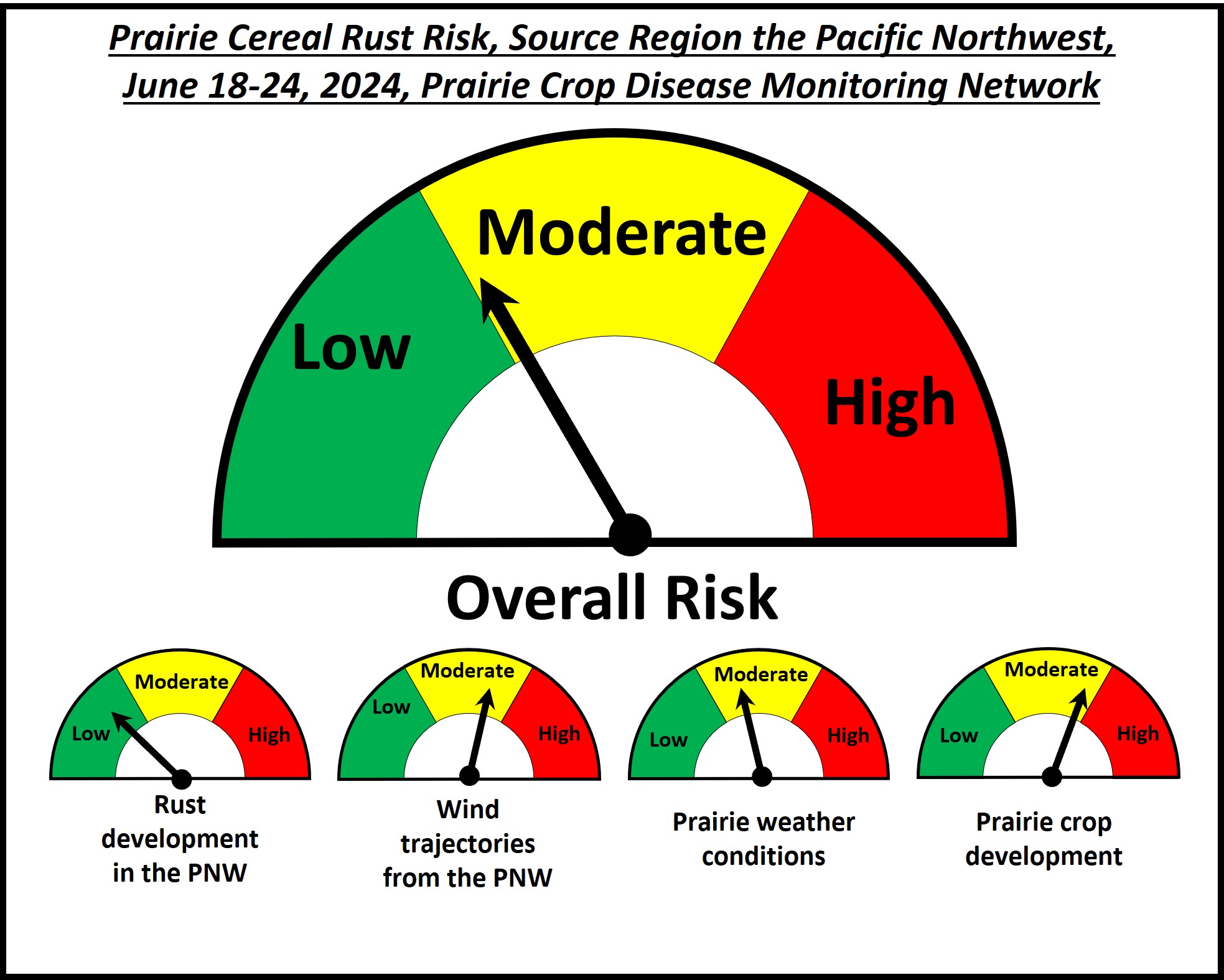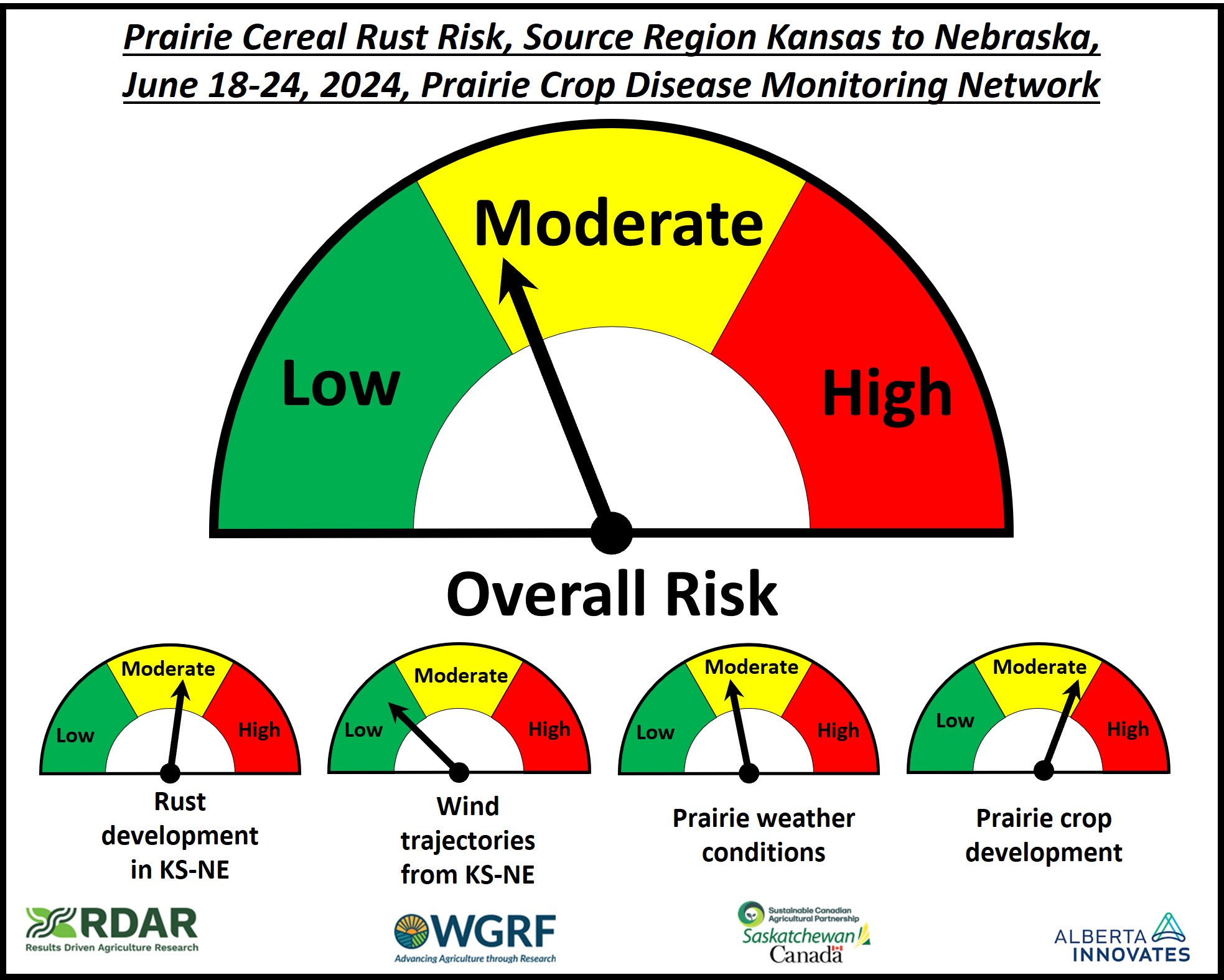The seventh weekly Prairie wind trajectory cereal rust risk report for 2024 is available for download now at the following link: June 18-24, 2024, report.
As of the week of June 18-24, 2024, the overall Prairie cereal rust risk assessment and need for in-crop scouting is as follows:
Pacific Northwest – There were moderate-high numbers of reverse wind trajectories that passed over the PNW region and into the Prairies, while the most recent reports available indicate that stripe rust development is limited in commercial fields, although there are concerns that it could restart in previously sprayed commercial crops. Prairie winter wheat crops are generally progressing from flowering to grain filling, while much of the spring wheat crop is moving into to the tillering and stem elongation stages, with some reports of crops at the heading stage in Manitoba. This past week meteorological conditions have been warm and wet across southern Manitoba. Overall, as of June 26, 2024, the risk of stripe rust appearance from the PNW is low-moderate and scouting for this disease in the Prairie region as a result of PNW rust inoculum is generally not urgent, although areas with an increased number of trajectories may be at higher risk. The recent appearance of stripe rust in Montana brings the stripe rust issue very close to the Prairies, especially the central to western regions, so scouting for stripe rust is advised for fields planted to varieties that have susceptible to intermediate resistance ratings.

Kansas-Nebraska corridor – There were 46 reverse wind trajectories that passed over the KS/NE region and into the Prairies from June 18-24, 2024, while in May and earlier in June stripe and leaf rust (Kansas) development were reported in commercial winter wheat fields in this region. However, Kansas winter wheat crops are progressing and as of June 23, 2024, 94% of the crop mature, with 53% being harvested in Kansas. Therefore, the Kansas winter wheat will no longer represent a significant source of rust inoculum. However, the most recent reports from Nebraska (June 14, 2024) indicate that stripe rust is present in all wheat producing areas, with up to severe levels being observed in irrigated fields or where rainfall occurred. Prairie winter wheat crops are generally progressing from flowering to grain filling, while much of the spring wheat crop is moving into to the tillering, stem elongation and flag leaf emergence stages, with some reports of crops at the heading stage in Manitoba. This past week meteorological conditions have been warm and wet across southern Manitoba. Rainfall in regions with higher amounts could facilitate deposition of rust spores into cereal crops and subsequent disease development. Overall, as of June 26, 2024, the risk of stem, leaf, stripe, and crown rust appearance from Kansas-Nebraska corridor inoculum is low-moderate and scouting for these diseases in the Prairies is generally not urgent, although areas with an increased number of trajectories may be at higher risk. The early and widespread appearance of stripe rust in the PNW and KS/NE regions is still concerning, while continuing stripe rust observations from North Dakota, South Dakota, Minnesota and Wisconsin bring the stripe rust issue very close to the Prairies, especially the central to eastern regions. Thus, scouting for stripe rust is advised for fields planted to varieties that have susceptible to intermediate resistance ratings, especially in the central to eastern Prairie regions.

This past week meteorological conditions have been warm and wet across southern Manitoba. Many locations reported precipitation amounts in the range of 20-50 mm (June 17-23, 2024). Since April 1, southern Manitoba has had rainfall amounts that have been greater than 200% of average cumulative amounts. Surface (<5 mm depth) soil moisture was relatively high over the past 7 days. Reverse trajectories have crossed over a number of these locations. For example, Carman had 8 reverse trajectories (6 from the Pacific Northwest and 2 originating over Kansas and Nebraska). Results for June 17-22 indicate that reverse trajectories, passing over Kansas and Nebraska were less than 1000 m above ground level and were approximately 500 m above ground level when air parcels crossed into Manitoba on June 21. Similar to last week, these results suggest that potential risk of introduction of pathogens into Manitoba could be high for those trajectories that occurred from June 18-24, 2024. Thus, scouting for stripe rust symptoms is advised in winter and spring wheat crops, especially in Manitoba.
Prairie winter wheat fields are most at risk as they are at the flag leaf to flowering stages but fortunately most current winter wheat varieties have intermediate to high levels of resistance. However, AC Radiant, CDC Buteo, AAC Elevate, Broadview, and CDC Falcon are rated as susceptible (Refer to the Alberta Seed Guide, Saskatchewan Seed Guide, Manitoba Seed Guide).
In terms of spring wheat (various classes) and durum the following varieties are either an S or MS: 5700PR, AAC Cameron, AAC Iceberg, AAC Tisdale, AAC Tomkins, AAC Warman, AAC Whitefox, AC Foremost , Cardale, CDC Abound, CDC Adamant, CDC Flare, CDC Pilar, Faller, Prosper, SY Natron, SY Rorke, SY Torach, and Unity. If you are growing a stripe rust susceptible variety, it will be important to keep an eye on your crops for stripe rust especially and follow further PCDMN cereal rust risk reports. Furthermore, the recent Manitoba observation of stripe rust was from a variety with an intermediate rating so monitoring crops planted with varieties with intermediate resistance should also be considered.
One question producers and consultants may have is in relation to fungicide timing for stripe rust. In general, for wheat leaf spot diseases such as tan spot and the septoria complex the key leaves are in the upper canopy, especially the flag leaf and penultimate (second leaf from the head) leaves. A previous PCDMN covers scouting and risk assessment recommendations for cereal leaf spot diseases. For leaf spots such as tan spot and the septoria complex in wheat, and scald, both forms of net blotch and spot blotch in barley, fungicide at herbicide application timings do not provide the best response in terms of disease management and crop productivity.
Exceptions occur with cereal rust diseases, especially stripe rust, where a herbicide timing application can be more useful. This is likely due to the biotrophic nature (i.e. they derive nutrients from living host tissues) of the rust pathogens and that initial rust inoculum typically comes from outside the crop, especially for spring cereals. In contrast, cereal leaf spot diseases (scald, net blotch, spot blotch, tan spot, septorias) are necrotrophic in nature (i.e. the derive nutrients from dead plant tissue), while initial inoculum typically comes from old crop residues in the same field where the crop is growing. Fungicide movement to the rust pathogen in living host tissues may be more extensive versus through dead plant tissues in the case of necrotrophic leaf spot pathogens. In addition, cereal leaf spot inoculum is continuously produced from old crop residues and thus can infect any new leaves produced immediately after spraying has occurred.
Once stripe rust appears in a Prairie wheat crop further development is favoured by moist humid conditions and cool to moderate temperatures. Based on information from Dr. X. Chen, WSU, Pullman, Washington, fungicide application for stripe rust is recommended from the herbicide timing stage through to flowering when the % of plants infected or the area of leaf infection approaches 5%. Staying on top of an emerging stripe rust problem in your Prairie winter or spring wheat crop is critical as yield losses are greatly increased when the disease becomes established, especially before head emergence.

